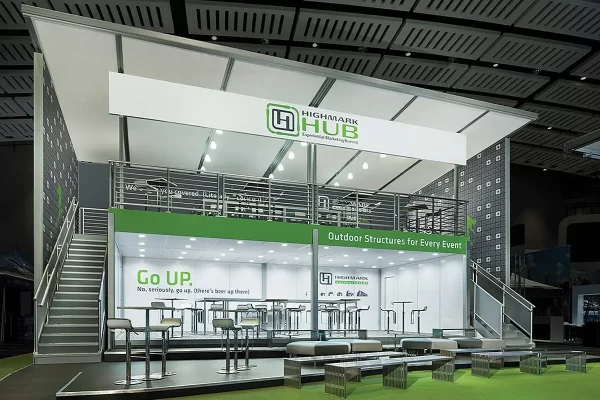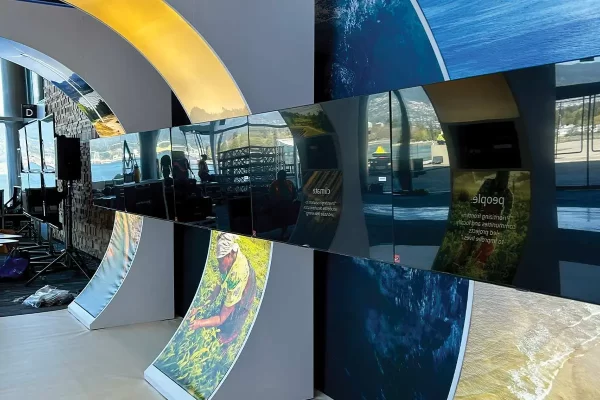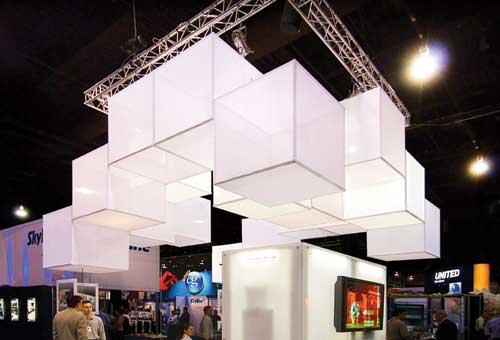
Traditional modular-style tradeshow exhibits are being eclipsed by newer designs relying upon the flexibility of tension fabrics and causing a revolution in the exhibits industry in the process.
Traditional building structures typically rely upon compression loading to remain erect, but structures made of fabrics rely upon the tension created from the pulling apart of fibers in the fabrics. Because tension fabrics are light, reusable and relatively easy to print upon, they have become an increasingly important part of today’s exhibits and tradeshows.
“There seems to be a growing market. Drayage costs are much more affordable because tension fabrics are light and easy to carry,” said James O’Connor, owner, Enhance a Colour Graphics Services.
To work properly, tension fabrics must be pre-stretched to ensure they are capable of withstanding the anticipated load, according to the University of Southern California (USC). Too much stretch means support structures will have to be larger to contain the greater load caused by the greater tension. Too little stretch means the tension-fabric structure is vulnerable to wind and other lateral forces.
Structures built of tension fabrics either have air-pressure supported systems or tension-membrane systems that rely upon cables and typically metal support structures, according to USC researchers. While larger structures, such as domed stadiums, generally have relied upon air-supported systems, smaller structures using cables and aluminum extrusions have enabled exhibit designers and printers to greatly expand their creativity. And advancements in printing techniques means there are nearly limitless options for creativity when applying them to tension fabrics.
“Printing is like painting – the material is your canvas. The people who use it best can take the conversation outside of graphics,” said Leo Boczar, director of communications for Fabric Images.
Many printers now offer a dye-sublimated printing process capable of producing a wide, seamless print. The colors are more resilient when using dye-sublimated printing versus solvent-based printing techniques and much faster and more affordable than traditional hand-painting. But exhibits typically use smaller panels, and many printers still use older methods to transfer images and logos.
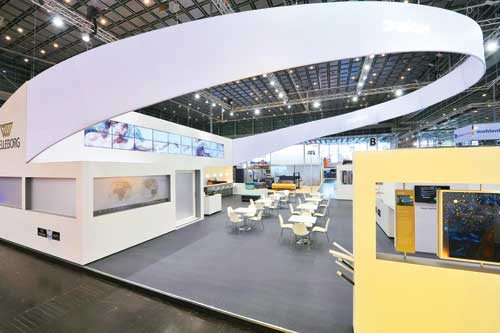
“The colors are more vibrant (with dye sublimation), but the fabric doesn’t come more than 10 feet wide,” said O’Connor. “Basically, some printers use dye sublimation while others use UV ink. It’s just a matter of what you are comfortable with.”
Most exhibitors use Celtic cloth-based tension fabrics for their displays. But fabric types vary greatly, and interior designers are having a greater impact on the types of fabrics used in their designs.
“What we are starting to see now are designers ordering material for a particular function. They want a specific shape, and we have hundreds and hundreds of options,” said Boczar. “When creating exhibits, many designers want to have a leather look or similarly familiar fabric textures commonly found in many homes and offices.”
Nearly all kinds of tension fabrics use some sort of polyester-based fibers, and larger exhibit firms have the luxury of being able to specially order tension fabrics for specific designs and applications, according to Boczar. But all firms keep a quantity of Celtic cloth tension fabric on hand due to its extreme popularity and ease of use. A Celtic cloth fabric has a matte surface with a soft finish and reacts well to various printing processes, which have become much more advanced.
“The dot size and print head are getting better. Now we have better tints, vignettes and flesh tones,” said O’Connor.
But the biggest advantage for tension fabrics is in drayage costs, which are much lower than with other fabric types. Because tension fabrics are relatively light and durable, it is much easier for installation and dismantling crews to transfer the contents to and from transportation vehicles, saving exhibitors a great deal on drayage expenses as well as shipping costs.
But what makes for an ideal substructure for tension-fabric designs?
“Aluminum is not going anywhere. It’s durable and the lightest and easiest to weld and can be reused. It’s just a matter of what you want to do with it,” said Boczar. “You can get it in extrusions and tubing and do whatever you want. Carbon fiber has been tried but is too expensive.”
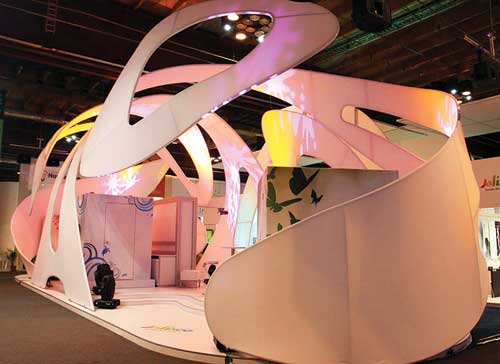
While printing techniques are advancing, so are lighting techniques designed to enhance the experience for exhibitors and their tradeshow visitors. With advancements in tension fabrics, it is possible to use lighting in ways never before considered.
“From our experience, we use smooth or brushed white cottons the most with great results,” said Boi Smit, president, Cees Smit. “Also, a variety of polyester material is a good option. These materials are often times a bit brighter white and have some gain. However, for some applications, a more soft light reflection is desired.”
The Cees Smit Group ranks among industry leaders in design and use of tension fabrics. The firm has developed a flexible fabric capable of adapting to any potential exhibit design to create custom exhibits instead of more plain, modular structures. And advancements in exhibit lighting are helping create more demand for tension fabrics.
“We have tension fabrics with or without coating. Without coating, the light source should be a certain distance to the fabric or the light hotspot will be visible. With the special coated stretch fabric we have developed, when lit from behind, the light will be diffused and a hotspot is never visible, regardless the distance,” said Smit. “When front projection is desired we would recommend our custom designed block-out stretch fabric, which contains a black inner core preventing the light from being visible on the reverse side.”
Although a variety of tension fabrics and other materials are being designed and created by Cees Smit and other firms, cost and proprietary rights can be obstacles to their use in tradeshows and exhibitions.
“All vendors will most likely continue to use their current fabrics, but I expect them to use tension fabrics more, because it has more tolerance in terms of fitting,” said Smit. “On the other hand, these materials are more expensive than non-stretch materials, so it also depends what the application is when choosing the fabric to use.”
Stretch fabrics enable exhibit designers and builders to create shapes that look natural but are unlike anything else. Stretch fabrics remain the most popular and versatile type of tension fabric, but new types of stretch fabrics that simply can be wiped off for post-show cleanup are proving popular among exhibitors.
With advancements in fabric designs, lighting and sound attenuation, it is likely tension-fabric exhibits will continue dominating more traditional, modular forms of exhibit design as much for aesthetics as for cost savings for years to come.











